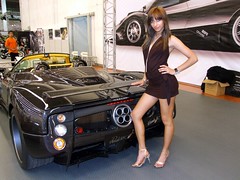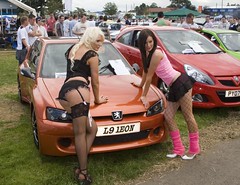At the same time the big-block Chevy 454SS was being developed, in another division of GM, engineers were cooking up a performance truck with an entirely different recipe, a truck that lives on in legends and myths today: the GMC Syclone. First, a minor point: yes, Syclone is spelled wrong. Mercury (remember them?) held the trademark for the Cyclone name, and Ford wasn’t about to give it up to their rival. The Syclone was a remarkable vehicle in many ways, but mostly for it’s ability to leave a stoplight like someone had strapped a JATO rocket to the bed and lit the fuse.
The project started out as a modified Buick Grand National drivetrain slipped into an S15 truck. The Buick 231cid V6 (3.8L) was tuned to about 300bhp, mated to a 200-R4 automatic and driving the rear wheels only. The truck had a 12-bolt rear end with a 3.73:1 final drive, and with sticky 255/60/15′s in the back, it managed a best time of 12.57@109mph. However, when the project headed for production, the decision was made to add electronic all-wheel-drive and use a GM Truck engine rather than the Buick V6. The concept was similar but the execution was different.
Based on the unremarkable GMC S15/Chevrolet S10 compact pickup, the Syclone packed a 4.3 litre Chevy 90° Vortec V6. Attached to this was a single Mitsubishi TD06-17c turbocharger breathing through an integrated air-to-water intercooler to the tune of 13psi, as well as multi-port fuel injection in place of the Grand National’s sequential fuel injection. The transmission was a 700-R4 electronically controlled 4-speed automatic with a 2100-stall torque converter, hooked up to the viscous-coupling AWD system from the Astro van via a Borg-Warner transfer case and a 3.42:1 final drive ratio. The variable-split AWD system directed 35% of torque to the front and 65% to the back. With 280 horsepower on tap (285 in the later Jimmy-based Typhoon) at 4400 rpm, as well as a monster 360 lb-ft of torque at 3200 rpm, the Syclone was -- and still is -- the fastest accelerating production truck ever.
Skip ahead to around 1:12 in this video to see a tuned SRT-4 getting absolutely owned by an old GMC Truck.
How fast was it, exactly? Ridiculously fast. The technique for getting a Syclone off the line was not difficult thanks to the AWD and high-stall automatic. Just hold the brake down hard, and floor the gas -- this’ll lock up the torque converter and get the turbo spooling up. Pop off the brake, keep the gas floored, and the 3500lb Syclone would rip to 60 mph in under 5 seconds and to a low or mid 13 seconds quarter mile time. To put that in perspective, Car & Driver tested the ($26,120) GMC Syclone against the ($122,180!) Ferrari 348ts in 1991, the article can be found here . The Syclone, to put it nicely, blew a nice hole right through the Ferrari. Some statistics -- 0-30mph, Ferrari 2.0s, GMC 1.6s. 0-60mph, 6.0 seconds for the Ferrari, 5.3 seconds for the GMC. Quarter mile? 14.1 seconds at 93mph for the GMC, 14.5@99mph for the Ferrari. By 100 the Ferrari had gained a lead (hey, a Syclone has the aerodynamics of a barn!), 15.3 seconds to the GMC’s 17.8. And of course the Ferrari would top out at 166mph, whereas the truck was only good for a piddling 126. But you could buy almost 5 Syclones for the price of one slow Ferrari, which sort of says a lot more than purely academic 100mph+ numbers.
The Syclone was produced in very limited numbers between January and July for the 1991 model year, with only 2,995 being sold. The powertrain was transferred into the Typhoon for the 1992-1993 model years, which was the same thing but in a 2-door Jimmy (Blazer) body with a nicer interior (leather seats, new steering wheel, etc) and air springs in the rear to soften the ride. Only 4697 Typhoons were made over it’s two year model span, making the SyTy twins exceedingly rare trucks. To this day there hasn’t been a faster-accelerating production truck. Syclone/Typhoon owners are usually one of two types -- they either keep their trucks hermetically sealed under a dust cover in a hidden garage and brag about their 3-digit odometer numbers, or their trucks have almost no stock components remaining, push 20+psi of boost, and brag about their 3-digit quarter mile numbers. These sophisticated sleeper trucks still command huge prices today -- even a beat up basket case of a high-mileage Syclone will probably net 10 grand -- and are extremely hard to find, or for that matter pry from the hands of their cherishing owners.
Ford didn’t want to miss out on the Sport Truck party, either. The second product of Ford’s SVT (Special Vehicles Team, the replacement for the defunct SVO group), after the 1993 Mustang Cobra, was the 1993-1995 F-150 Lightning. Based on the last of the square-bodied F-150′s, the Lightning was another typical “huge engine” sport truck. At the time, the biggest engine you could get in an F-150 was a 302ci (that’s 4.9L, Vanilla Ice, get it right) V8. The Lightning ditched the 302 for a 351ci “Windsor” V8, a 5.8L powerhouse. With GT40 high-flow heads and hypereutectic pistons, the Lighting’s 351 punched out 240 horsepower and 340lb-ft of torque. The 4-speed automatic transmission was fortified with a limited-slip differential, 4.10:1 gears, and an aluminum balanced driveshaft. 17″ alloy wheels with fat Firestone performance tires as well as a tighter suspension (1″ lower front, 2.5″ lower rear) provided grip (0.88g of lateral grip, a dubiously high-sounding number in retrospect). The Lightning was both a fun truck and a work truck -- it could still tow, it still had a good payload capacity, and it would give a VW GTI a solid spanking from a stop light -- 0-60 in 7.4 seconds with a 110mph top speed was quick by car standards for 1993, absurd by truck standards. Ford made 11,563 Lightnings over it’s three-year production span, with production ending in 1995.
Dodge continued their tradition of big V8′s in small trucks with the 1998 Dakota Sport 5.9 R/T. As suggested by the name, Chrysler heaved out the 318ci V8 for the Ram’s bigger 360ci (5.9L) Magnum V8, meaning this compact pickup had a bigger engine than a Corvette. Of course, the old-school iron block pushrod 360 V8 only made 250 horsepower, but as with all these trucks, torque was the strong point -- 345 lb/ft of the stuff! It was mated to a 46RE heavy-duty 4-speed automatic transmission with a limited-slip rear end, lowered suspension, and beefy 17″ wheels mounting 255/50/17 performance tires. Available in single and cab-and-a-half form, the Dakota 5.9 R/T was produced alongside the second-generation Dakota for almost it’s whole lifespan, up until 2003. The huge 5.9L engine stayed around even while the Dakota switched from the 5.2L pushrod V8 to the weak-kneed 4.7L SOHC V8, a move many Mopar enthusiast disliked -- less low end torque and lower observed fuel economy, mainly. The Dakota 5.9 R/T would run to sixty in a tick over 7 seconds, and lay down a 15.5 quarter mile at just under 90mph -- not too shabby.
Ford brought the sport-truck game to a whole new level in 1999 with the second-generation F-150 SVT Lightning. Gone was the old square body, replaced by the new “Aero” F-150 styling that was a love/loathe proposition. Gone, also, was the old-school 351 Windsor V8, replaced by a smaller 5.4L SOHC 16v Triton V8. With an iron block and aluminum heads, the Lightning (like it’s geological-event-name brother, the Syclone) relied on boost to make power. Strapped to the top of the engine was an Eaton supercharger breathing through an integrated air-to-water intercooler making 8psi of boost. Coolest feature? The factory-equipment side exit dual exhaust system, that poked out of a cut-out behind the cab on the passenger side. With supercharger screaming and tires boiling, the newly fortified SVT Lightning would rocket to 60mph in 5.8 seconds, and run a quarter-mile just over 14 seconds -- or quick enough to show tail lights to a Porsche Boxster, all day long.
The 2nd-generation Lightning saw an update for the 2001 model year, with some refinements and improvements. The intercooler was updated with more rows for better cooling as well as a redesign to prevent leaks. The 4R100 4-speed automatic’s rear end gear was shortened from a 3.55:1 to a 3.73:1, and the 3.5″ steel driveshaft was replaced with a 4.5″ aluminum driveshaft. Improvements to cooling and intake ducts also helped push power from 360 to 380bhp, and torque from a massive 440 to 450lb-ft. Newly fortified, the 2001 Lightning could smoke a Boxster S. 0-60 was recorded in 5.2 seconds, along with a 13.9 second quarter mile time and a 143mph top speed. In addition to great gobs of gutteral grunt, the SVT engineers also taught the Lightning to dance. The front suspension was the same short-and-long control arm coil spring setup, but the rear suspension (a live axle) was upgraded from a 3-spring to a 5-spring setup, and ride height was lowered 1″ front and 2″ rear. A fat 23mm rear sway bar and high-performance Monroe shocks (Bilsteins in 2001+models) helped keep the truck planted. Despite their massive size (295/45/ZR18), the rear Goodyear Eagle GS tires always seemed to have some trouble putting all that supercharged torque down.
In fact, when asked what stock vehicle does the best burnout, most car guys will grudgingly admit that nothing tops the supercharged Lightnings -- tons of torque at low rpm, almost no weight over the rear wheels, strong front brakes and an automatic all lead to huge clouds of tire smoke. The SVT Lightning went out production in 2004, and it’s interesting to note that it’s sales stayed pretty solid throughout it’s entire run, averaging about 4,500 units per year. Today, the Lightning is still immensely popular with performance enthusiasts despite the fact that it’s a truck. Why? Because 380 horsepower and 450 lb-ft is just the start. These 5.4L supercharged motors respond especially well to tweaking, with a typical bolt-on regimen (a chip-tune, bigger injectors, a supercharger underdrive pulley to spin it faster, and exhaust work) easily netting close to 500whp.
Since the Lightning was only a single-cab flareside truck (for the purpose of weight balance), Ford also sold a softer, slightly goofier version of the Lightning with a four-door cab, called the F-150 Harley Davidson. Named after the anachronistic motorcycle maker that caters to lawyers and dentists that like dressing like pirates, the chromed-up Harley Davidson was detuned to 340 horsepower and 425lb-ft of torque. It could still run to sixty in close to six seconds, which helped to avoid having people see you behind the wheel of a Harley Davidson TRUCK. Moving on…
In Part III of this article, I’ll be covering the current generation of muscle trucks produced starting 2000 to the present day. Stay tuned!























